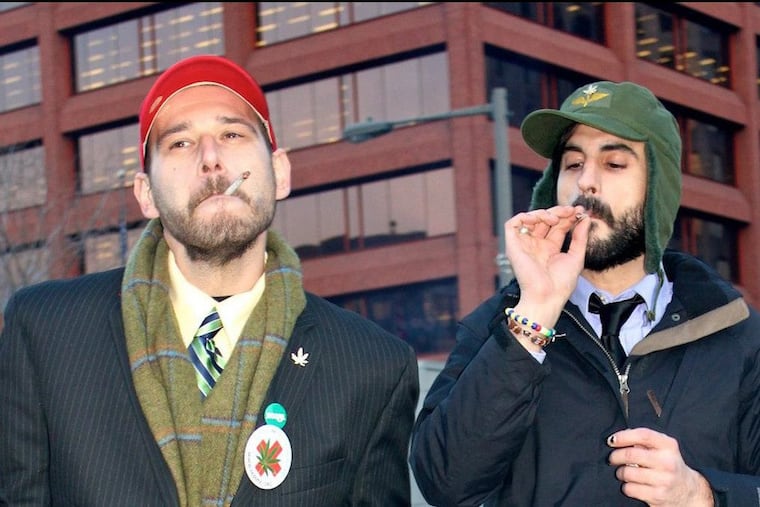Timeline: Marijuana legalization milestones in Philly and beyond | Philly 420
October marks important milestones in the strange policies around cannabis.

October is a special month for those who follow the history of marijuana in America. It brings the traditional harvest of bountiful, green cannabis flowers across the country, but in a twist of fate, this month also marks milestones in the strange policies around the plant.
Oct. 1, 1937: The first federal marijuana law
Harry Anslinger Jr., the first commissioner of the U.S. Treasury Department's Federal Bureau of Narcotics, spent all of 1936 deploying the original version of fake news by putting the movie Reefer Madness into every theater in the country. In his tenure, Anslinger brought together a strange mix of businesses, law enforcement, and political groups who sought the passage of a law that put marijuana cultivation, sale, and consumption under the complete purview of law enforcement. The law and the lobbying to support it were infamously more about persecuting nonwhite citizens than they were about cannabis. The culmination was the Marihuana Tax Stamp Act.
Congress heard just nine hours of testimony, in which only the American Medical Association offered passionate opposition. President Franklin Roosevelt signed it, and on Oct. 1, 1937, the first broad federal marijuana law was implemented.
Oct. 5, 1937: The first marijuana-related arrests
At dawn on this day in Denver, local police were led by FBI agents to stalk two men who were said to be selling marijuana at the Lexington Hotel. Samuel R. Caldwell and Moses Baca, two poor farm laborers, were arrested without incident and in possession of a few rolled joints. This was the beginning of federal cannabis prohibition.
Caldwell and Baca were tried in federal court and sentenced to four years and 18 months, respectively, of hard labor at Leavenworth Federal Penitentiary.
Oct. 27, 1970: The Controlled Substances Act
In 1965, an incident at the Texas-Mexico border set up another major October for marijuana policy: Timothy Leary, the psychedelic trailblazer, was driving back into the United States with family, friends, and a few ounces of cannabis. When officers found the marijuana, Leary was arrested and convicted of possession under the Marihuana Tax Stamp Act.
Leary challenged the conviction and his case made its way to the U.S. Supreme Court by 1969. In a unanimous decision, the Marihuana Tax Stamp Act was struck down as an unconstitutional tax.
But President Richard Nixon and Congress had seen the ruling coming miles away and set about carefully building the now-familiar modern structure for criminal prohibition: the Controlled Substances Act (CSA).
Like Anslinger's motivations, the CSA had race-based enforcement at the core. It created the drug scheduling scheme and put marijuana next to heroin. Meanwhile, cocaine and morphine, which were sold in pharmacies, were scheduled below cannabis. Alcohol and tobacco were left out of the CSA completely. It was implemented Oct. 27, 1970.
October 2012-13: Independence Hall is the site of monthly marijuana events
By October 2012, there were no cannabis reform laws on the books in Pennsylvania. A handful of local cannabis activists — myself included — planned an event to highlight the 1930s arrests of Caldwell and Baca. Standing in the open grassy area in front of Independence Hall, we lit a joint, held up Caldwell's mug shot, and made statements to a few reporters.
By October 2013, thousands had turned out for monthly "Smoke Down Prohibition" events at Independence Hall, where citizens gathered for speeches and to light joints. Hundreds of National Park Service rangers and local police eventually intervened.
Along with others, I was cited and taken to federal court over half a joint. Along with a $3,000 fine and two years of probation, my federal record still makes getting into Canada dicey.
Oct. 20, 2014: Philly becomes the largest U.S. city to implement marijuana decriminalization
After a year of debate and political wrangling, Philadelphia became the largest U.S. city to implement an ordinance to decriminalize marijuana possession, on Oct. 20, 2014. Civil fines were set at $25 for possession of up to 30 grams of flowers or 8 grams of hash/concentrate and $100 for smoking in public. Arrests for cannabis plummeted in the city, going down almost 80 percent in the first year.
October 2017: Where we are now
Liberty and real freedom for cannabis consumers in Pennsylvania are not coming fast enough. Marijuana arrests across Pennsylvania are rising. Decriminalization citations in Philly have almost doubled.
Harrisburg, Pittsburgh, State College, and York have enacted their own decriminalization ordinances, but with stiffer fines. Pennsylvania's extremely limited medical cannabis-oil law has become the realm of lawyers and millionaires instead of patients and families. Pennsylvania's elected officials scratch their heads for new tax revenue to fix a broken budget in Harrisburg while voters poll increasingly in favor of a legal solution.
Meanwhile, Delaware is home to an official state task force on legalizing marijuana, and New Jersey is well-positioned for a retail cannabis market in the next two years.
It is time for us to chart a better path forward. When politicians and police stop treating cannabis consumers like criminals, Pennsylvania can gain thousands of jobs and millions in tax revenue.
I hope that by next October, the verdant harvest of Pennsylvania cannabis is something that will benefit every single resident of the commonwealth.